Your guide will meet you at the airport and continue directly into the dunes in search of Namibia’s only true endemic, the Dune Lark. From there you will continue to the Walvis Bay lagoon and bird the remainder of the day along this spectacular lagoon.
Walvis Bay is blessed with a rich biodiversity which thrives in the scenic Namib Desert dunes and associated gravel plains, the Walvis Bay Lagoon, the ephemeral Kuiseb River Delta and other ecosystems.
The ideal time to visit Walvis Bay is from October to April, when the migrant birds have moved in from the northern hemisphere in their thousands. The sheer numbers of the birds around the lagoon are impressive and the area has the highest density of Chestnut-banded Plover in the world. The Lagoon happens to be one of Africa’s most important shorebird stopovers (it is a RAMSAR site), where you can see incredible numbers of Greater and Lesser Flamingos and some extremely localised species, such as the diminutive Damara Tern.
Some of the most abundant of the migratory species are Common Greenshank, Marsh Sandpipers, Black necked (Eared) Grebe, Red Knot, Ruddy Turnstone and Curlew Sandpiper. Whimbrel, Curlew and Bar-tailed Godwit occur in smaller numbers. This lagoon is one of the few sites in southern Africa where Common Redshank, Eurasian Oystercatcher and Red-necked Phalarope are fairly regular. This phenomenal wader spot also regularly attracts Greater and Mongolian (Lesser) Plover, Terek Sandpiper and birds that are much more typically found on the subtropical east coast of southern Africa. Resident birds of the lagoon include Pied Avocet, Black-winged Stilt, White-fronted Plover, and the sought-after Chestnut-banded Plover.
Pelagic seabirds that can often be seen from Paaltjies: White-chinned Petrel, Sooty Shearwater, Wilson's Storm Petrel, Cape Gannet, Pomarine and Skua.
Other birds we will look out for around Walvis Bay: Red-faced Mousebird, Dusky Sunbird, Orange River White-eye, Pale Chanting Goshawk and Bokmakierie.
- Swakopmund & Walvis Bay
Key species: Damara Tern, Dune Lark, Gray’s Lark, Tractrac Chat (pale form), Bank and Crowned Cormorant, Orange River White-eye, Karoo Eremomela
Other species: Kelp, Grey-headed and Hartlaub’s Gull, White-breasted Cormorants, Greater and Lesser Flamingo, Ruddy Turnstone, Marsh, Curlew and Wood Sandpipers, Black-necked (Eared) Grebe, Red Knot, Bar-tailed Godwit, Red-necked Phalarope, Swift, Caspian, Common, Sandwich, Black, White-winged and Caspian Terns, Whimbrel, Chestnut-banded, Grey and White-fronted Plover, Sanderling, Eurasian Curlew, Redshank, Greenshank, Terek Sandpiper, Maccoa Duck, Cape Shoveler, Little Grebe (Dabchick), Parasitic Jaeger, Brown Skua, Cape Gannet, Sooty Shearwater, Red-capped Lark, Bokmakierie, Chestnut-vented Warbler, Yellow-bellied Eremomela, African Reed Warbler, Rosy-faced Lovebirds, Red-eyed Bulbul, Dusky Sunbird, Scarlet-chested Sunbird, Black-chested Prinia, Rock Kestrel, Peregrine Falcon, Pririt Batis.
Habitat: A good spread of Namib habitats exist along the coast. Coastal gravel plains are open and largely unvegetated. The dune fields can be split between coastal unvegetated dunes on the Atlantic Ocean and vegetated dunes a little further inland.
Two major river systems namely the Kuiseb River and Swakop River, which are considered linear oases, have an established vegetation line.

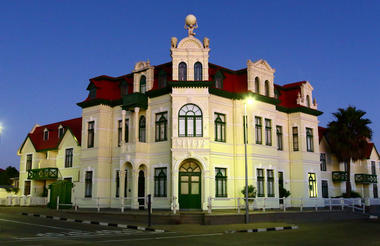
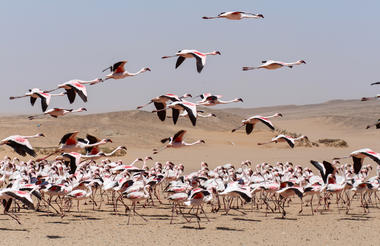
After breakfast we will continue birding along the coastal desert. Once we have found all our targets around Walvis Bay and Kuiseb Delta area we will head towards Swakopmund and bird in the surrounding gravel plains, salt pans and the Swakop River Valley for the pale form of Tractrac Chat, Familiar Chat, Red-capped Lark and with luck Rufous-eared Warblers and Karoo Eremomela. Interesting waders such as Kittlitz’s and Chestnut-banded Plovers as well as African Black Oystercatcher, White-breasted, Bank, Cape and Crowned Cormorants, Maccoa Duck, Cape Shoveler, Grey-headed Gull and Little Grebe (Dabchick) can also be found here.

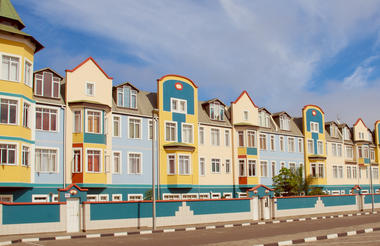
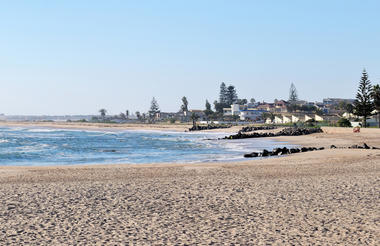
Today we head to the mighty Erongo Mountains via Spitzkoppe. The Spitzkoppe is one of a series of impressive granite inselbergs that rise steeply out of the desert plains. It is at this imposing Batholith where we have our best chance of finding Herero Chat. Along the way we may also encounter the rare and declining Burchell’s Courser and many other sandy desert species like Stark’s Lark and other strategic species like Karoo Long-billed Lark. On the plains surrounding these hills we should see Rüppell’s Korhaan, Namaqua Sandgrouse, Chat Flycatcher and Karoo Chat, Verreaux’s and Booted Eagle, Augur Buzzard, African Hawk-Eagle and Lanner Falcon also occur in the hills as do Rosy-faced Lovebird, Carp’s and Ashy Tit, White-throated Canary, Layard’s Tit-Babbler, White-tailed Shrike, Double-banded Courser, Starks, Sabota, Red-capped, Spike-heeled, Fawn-coloured and Rufous-naped Larks, White-browed Sparrow-Weaver, Mountain Wheatear, Pale-winged Starling, Bradfield’s Swift, Rockrunner, Monteiro’s and Damara Red-billed Hornbill.
Birding in the Erongos is very rewarding and supports many of the Namibian near-endemics such as Violet Wood-Hoopoe, Damara Red-billed Hornbill, Rüppell’s Parrot, White-tailed Shrike, Carp’s Tit in the river beds, Rockrunner, Hartlaub’s Spurfowl and other specials like Freckled Nightjar and Rosy-faced Lovebird in the granite outcrops.
Other birds to look out for: Red-billed Spurfowl, Helmeted Guineafowl, Namaqua Sandgrouse, Rufous-naped and Monotonous Larks, Black-cheeked, and Violet-eared Waxbills, Southern Yellow-billed Hornbill, Monteiro's Hornbill, Golden-tailed, Cardinal and Bearded Woodpeckers, Orange River Francolin, Chestnut Weaver(rain dependent), Chestnut-vented Warbler, Verreaux’s Eagle-owl, Spotted Eagle-owl, African Scops-Owl, Pearl-spotted Owl and Southern White-faced Scops-owl.
- Spitzkoppe & Erongo Mountains
Key Species: Rüppell’s Parrot, Hartlaub’s Spurfowl, White-tailed Shrike, Carp’s Tit, Herero Chat, Violet Wood-Hoopoe, Rosy-faced Lovebird, Chestnut Weaver, Rockrunner, Rüppell’s Korhaan, Bradfield’s Swift, Burchell’s Courser, Freckled Nightjar, Layard’s Warbler, Damara and Montiero’s Hornbill.
Other Species: Stark’s Lark, Karoo Long-billed Lark, Rüppell’s Korhaan, Double-banded and Namaqua Sandgrouse, Chat Flycatcher and Karoo Chat, Verreaux’s and Booted Eagle, Augur Buzzard, African Hawk-Eagle, Lanner Falcon, Ashy Tit, White-throated Canary, Layard’s and Chestnut-vented Warbler, Double-banded Courser, Starks, Sabota, Red-capped, Spike-heeled, White-browed Sparrow-Weaver, Mountain Wheatear, Pale-winged Starling, Southern Pied Babbler and Acacia Pied Barbet.
Habitat: The habitat is mostly Pro-Namib vegetation types, Acacia scrub and large granite inselberg.

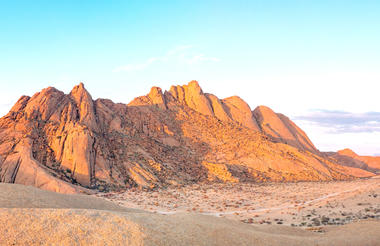

Today we will enter the Etosha National Park. The Park is the flagship of Namibia’s conservation areas, teeming with large game and boasting about 380 species of birds. You will be based in the park during the next 3 days and will spend time visiting a range of habitats. The grassy plains north of Okaukuejo Camp are the best areas in the park to see Pink-billed Lark, Double-banded Courser, Northern Black (White-quilled) Korhaan and Spike-heeled Lark. Raptors are abundant and we should see Martial Eagle, Secretary Bird, Bateleur, Ovambo Sparrowhawk, Tawny Eagle and Greater Kestrel. Migrant raptors such as Western Red-footed Kestrel, Lesser Spotted Eagle and Yellow-billed Kite can be seen in large numbers during the wet season. The camp situated in the centre of the park, Halali is the best site to see Violet Wood-hoopoe, Bare-cheeked Babbler and Carp’s Tit. In the East around Namutoni the open grasslands are home to Namibia’s isolated population of Blue Crane, Temminck’s Courser, Grey-backed and Chestnut-backed Sparrowlark and Eastern Clapper Lark. The elusive Black-faced Babbler occurs in dense Terminalia woodlands in this area. Floodlit waterholes at all three camps provide wonderful game viewing at night as well as providing opportunities to see nightjars and owls.
Etosha is famous for its large game populations and during our stay here we should see Lion, Elephant, Burchell’s Zebra, Red Hartebeest, Blue Wildebeest, Springbok, Oryx, Giraffes, Greater Kudu and several smaller antelope. Among the rarer species regularly seen are Black Rhino (especially at waterholes at night), Cheetah and Black-faced Impala, a subspecies only found in Namibia. Your visit here will be taken at a leisurely pace and there will be excellent photographic opportunities



- Okaukuejo area, Southern Etosha National Park
Key Species: Pink-billed Lark
Species: Secretarybird, Kori and Ludwig’s Bustard, Northern Black and Red-crested Korhaans, Glossy Starling, Yellow-bellied and Burnt-necked Eremomela, Fork-tailed Drongo, Blue Crane, Burchell’s and Double-banded Courser, Alpine Swift, Pale Chanting Goshawk, South African Shelduck, Green-winged Pytilia, Sociable Weaver, Pygmy Falcon, Southern Pied Babbler, Crimson-breasted Shrike, Violet-eared Waxbill, Red-headed Finches, Marsh and Barn Owls and Rufous-cheeked Nightjar, Shaft-tailed, Long-tailed and Pin-Tailed Whydah, Grey-backed and Chestnut-backed Sparrow-Larks, Red-capped, Spike-heeled and Rufous-naped Lark, Capped Wheatear, Scaly-feathered Finch, Namaqua Sandgrouse, Red-necked and Lanner Falcons, Lappet-faced, White headed and White-backed Vultures, Double-banded and Temminck's Coursers, Cardinal, Golden-tailed and Bearded Woodpecker, Brubru, Crowned Lapwing, Ashy tit, Red-billed Quelea, Rufous-eared Warbler, Red-breasted Swallow, Greater Kestrel, Desert Cisticola, Spotted Thick-knee, Southern Ant-eating Chat, Pied and Black Crow, Kalahari Scrub Robin, Martial and Tawny Eagle, Southern Yellow-billed and Grey Hornbill.
Habitat: This end of the park has large open grassland along the saline pan and is dispersed with Mopane woodland.



We will slowly amble through the park to the eastern side. We will stop in at Halali Camp for lunch where we will do some birding in the gardens.
- Halali area, Etosha National Park
Key Species: Bare-cheeked Babbler, Blue Crane, Violet Wood-Hoopoe and Damara Hornbill.
Other Species: Crimson-breasted Shrike, Great Sparrow, Violet-eared Waxbill, Southern Pied Babbler, Red-headed Finch, Kori Bustard, Scaly-feathered Finch, Marico Flycatcher, Namaqua Dove, Pallid and Montagu's Harrier, Little Sparrowhawk, Gabar Goshawk, Bateleur, White-crested Helmet Shrike, Southern White-crowned, Lesser Grey and Red-backed Shrikes, Golden Breasted Bunting, Ground Scraper Thrush, Lanner Falcon, African and Southern White-faced Scops-Owl, Lilac-breasted and Purple Rollers, Red-billed Buffalo Weaver, Long-billed Crombec, Willow Warbler, Spotted Flycatcher, Grey-backed Camaroptera, Martial Eagle, Mosque Swallow, Crested Francolin, Red headed Weaver, Carp’s Tit, Southern Red-billed Hornbill and Swallow-tailed Bee-eater.
Habitat: This part of the park has large open grassland along the saline pan and is dispersed with established Mopane woodlands.



We will have another day to explore the eastern and northern parts of the park. The area here is especially good for finding Leopard, White Rhino, Elephant, Spotted Hyena and Dikdik
- Namutoni area, Eastern Etosha National Park
Key Species: Black-faced Babbler, Blue Crane, Eastern Clapper Lark.
Other Species: Temminck’s and Double-banded Courser, Grey-backed Sparrow-Lark, Dusky Lark, Southern Pied Babbler, Shaft-tailed Whydah, Tawny Eagle, Rattling Cisticola, Ruff, Common Sandpiper, Egyptian Geese, Marico Flycatcher, Swallow-tailed Bee-eater, Banded and Sand Martin, Southern Red-billed Hornbill, Marico, White-bellied and Scarlet-chested Sunbirds, Chestnut-vented Tit-babbler, Fawn-coloured Lark, Kurrichane Button-Quail, African Harrier-hawk, Violet and Black-cheeked Waxbill, African Golden Oriole, Gabar Goshawk, European Roller, Crimson-breasted Shrike, Pale Chanting Goshawk, Southern White-crowned Shrike, African Paradise Flycatcher, Meyer’s Parrot, Violet-backed Starling, Crested francolin, Caspian Plover, Emerald Spotted Wood dove, White-browed Scrub Robin, African Palm-Swift, Red-billed and Swainson’s Spurfowl, Yellow-breasted Apalis, Chinspot Batis and Burchells’ Sandgrouse.
Habitat: The eastern side of Etosha is typical Karstveld and is a very different habitat to the rest of the park.


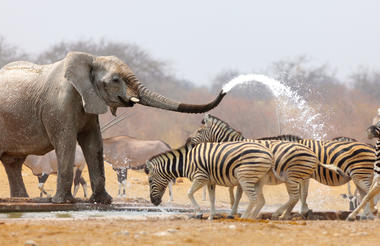
After a final game drive through the eastern part of the park we will depart towards Waterberg Plateau National Park.
This park was created as a sanctuary for the rare and endangered species of the Caprivi. The table top mountain plateau comprises a sandy plain flanked by 100 m high cliffs and scree slopes. The high diversity of birdlife in this semi-arid region is due to the location of the Waterberg at the meeting point of broad-leafed woodland on northern Kalahari sandveld on top of the plateau and mixed thorn bush savannah below, a third habitat is provided by the cliffs and scree slopes. The Acacia savanna and woodland here abounds with birds and is one of the best sights in the country to see near-endemics such as Rüppell’s and Meyer’s Parrot, Rosy-faced Lovebird, Violet Woodhoopoe, Monteiro’s Hornbill, Carp’s Tit, Hartaub's Spurfowl and Rockrunner.
Other exciting species that we might encounter during your limited stay include Bearded Woodpecker, Rosy-faced Lovebird, Bradfield’s, Alpine, African Palm, Little, Common and White-rumped Swifts, Freckled Nightjar, Red-billed and Spurfowl, Bradfield’s, Southern Yellow-billed, African Grey and Red-billed Hornbills. The Waterberg is also home to the last remaining population of Cape Vulture in Namibia which breed on the northern side of the plateau. With luck you will see some of these magnificent birds as well as other raptors including African Hawk-Eagle, Booted and Verreaux's Eagle, Peregrine Falcon and Augur Buzzard.
- Waterberg Plateau National Park
Key Species: Rüppell’s Parrot, Rosy-faced Lovebird, Violet Wood-Hoopoe, Damara Red-billed, Monteiro’s and Bradfield’s Hornbill, Carp’s Tit and Rockrunner and Hartlaub’s Spurfowl.
Other Species: Bearded Woodpecker, Swainson’s Spurfowl, Rosy-faced Lovebird, Bradfield’s, Alpine, African Palm, Little, Common and White-rumped Swifts, Freckled Nightjar, Red-billed Spurfowl, Southern Yellow-billed, African Grey and Red-billed Hornbills, African Green Pigeon, Cape Vulture, African Hawk-Eagle, Booted and Verreaux's Eagle, Peregrine Falcon and Augur Buzzard.
Habitat: The Waterberg is a large sandstone plateau and has a sandy Kalahari habitat on top and well-established Acacia scrub and ficus woodland on the edges.
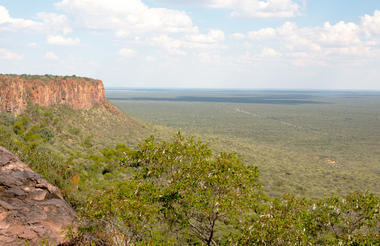
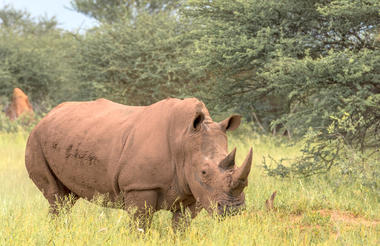
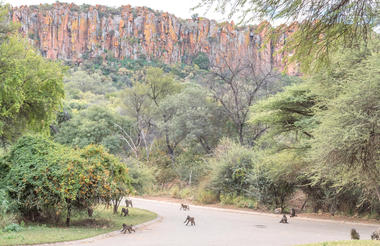
We will do some early morning birding before departing to Windhoek where we will be exploring the sparsely wooded hills and valleys surrounding the city. Rocky slopes should yield Short-toed Thrush, White-tailed Shrike, Barred Warbler and with luck Rockrunner.
- Greater Windhoek
Key Species: White-tailed Shrike, Chestnut Weaver, Rockrunner, Bradfield’s Swift, Orange River Francolin, Damara and Montiero’s Hornbill.
Species: Short-toed Rock Thrush, Barred Wren-Warbler, Palm Swifts, Rock Martin, Greater striped and Pearl-breasted Swallow, South African Shelduck, Cape Shoveller, Red-billed Teal, Desert Cisticola, Rattling Cisticola, Yellow-bellied Eremomela, Cape penduline Tit, Black-chested Prinia, Rosy-faced Lovebird, Ashy Tit, Marico Flycatcher, Pririt Batis, Crimson-breasted Shrike, Cape Glossy, Wattled and Pale-winged Starling, Dusky, Marico and Scarlet-chested Sunbird, Great Sparrow, Red-billed Spurfowl, Red-headed Finch, Red Bishop, Black-faced and Blue Waxbills, Red-billed Firefinch and several other Acacia savanna species.
Habitat: The habitat around Windhoek comprises of mixed Acacia scrub and schisty hillsides with drainage lines, that hold established Acacia woodland.



We will head out to Avis Dam where we should see Bradfield’s and Palm Swifts, Rock Martin, Greater striped and Pearl-breasted Swallow. Wetland birds are also abundant and South African Shelduck, Cape Shoveller and Red-billed Teal are usually present. In the shrub-lands surrounding the dam Desert Cisticola, Yellow-bellied Eremomela, Black-chested Prinia and a variety of seed-eaters are easily seen. Migrant waders are usually present in good numbers during the summer months.
Your guide will drop you off at the airport.


